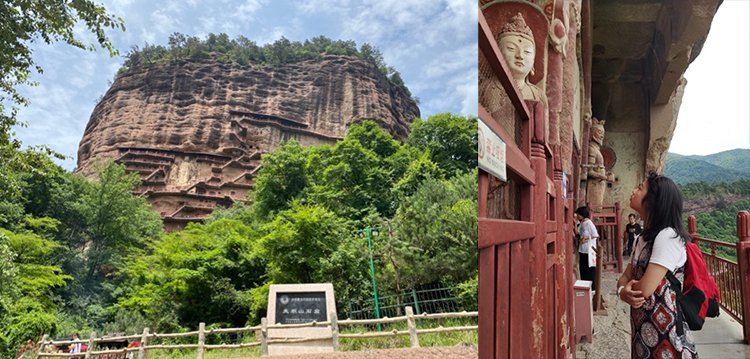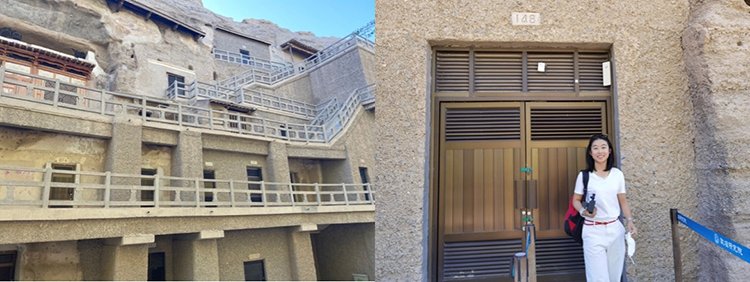Report: Visiting Buddhist Grottoes in North-West China, Summer 2021
This summer Ancient & Modern History undergraduate Rachel Lo travelled to the north-west of China for an academically stimulating adventure along the Hexi corridor, visiting multiple grottoes and learning about the fascinating art history of Buddhist cave paintings.
I began my adventure in Tianshui, a city in Eastern Gansu province, where I visited the Maijishan grottoes. I am very thankful towards Ms Zhang Quanjun, researcher of the Maijishan Art Institute, for guiding me around the grottoes. Her father, also a veteran researcher at the Institute, has gifted me a copy of his work, The Catalogue of Maijishan Grottoes (which kept me occupied over the summer!).



Being able to access the specially protected grottoes (nos. 133 and 135) was particularly eye-opening. What was most striking was a statue of the Buddha in cave no.133. The atmosphere I felt as I stepped into the cave was one of solemnity and authority - the Buddha is greater than life-size, looking down upon the viewer with strict, unwavering eyes. However, as the artificial lights were turned off and the natural sunlight let in, the emotion conveyed by the statue immediately changed. The blue-coloured gemstones used for the eyes were highlighted under natural light, which gave the Buddha a teary, emotional outlook. Rather than a solemn authority, the Buddha became a fatherly figure deeply connected to mankind and brimming with emotions. Only spectacular craftsmanship allowed a simple change in lighting to have such an effect on the emotions conveyed through a statue.

My other highlight of the trip was visiting the Mogao Grottoes in Dunhuang - a UNESCO world heritage site preserving some of the finest examples of Buddhist art and manuscripts dating from as early as AD366.

The diversity of cultural influences at Dunhuang (Chinese and Turkish powers were influential in the region, and it was a hub of trade) is well illustrated in one of the larger grottoes completed in the Yuan Dynasty - grotto number 61. There is a large wall painting of the Wutai mountains (located in the North East of China), in which temples, journeys of pilgrims and missionaries, and scenes of daily life are vibrantly depicted. On another wall was a procession of the grotto’s female patrons. Interestingly, one spots paintings of the 12 horoscopes here - clearly a Greek influence that spectacularly made its way across 6,000 kilometres to Dunhuang.

My guide for the day was Mr Lü Ai (associate of the Ming-Ai (London) Institute and a researcher at the Dunhuang Research Institute), whom I had met virtually last year at a series of Zoom talks on the Mogao Grottoes. He then showed us around his office in the multi-media department, and we talked about his team’s role in creating short films and immersive AR technologies to help visitors understand the history and the content of the grottoes during their visit. Indeed, on our visit, I personally experienced the benefits of watching the immersive videos at the start of the tour, in which I got to see the details of the wall paintings up close on a screen, before going to the grottoes to see them in person.

Apart from the two highlights of the trip, I visited several smaller grottoes along the route, including the West Thousand Buddha Grottoes and the Yulin Grottoes. One must not forget the breath-taking views of the Danxia landforms along the way!

I am eternally thankful to everyone who made this trip truly inspiring - Ms Zhang Quanjun, Mr Lü Ai, and especially to Lord Gerry Grimstone, without whom I would not have had the courage to reach out to the various grottoes’ experts for this trip. I am very grateful for his generosity and the impact it had on me.
